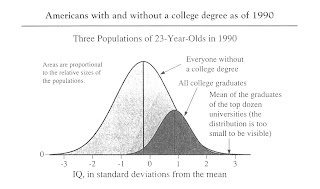 "The story of higher education in the United States during the twentieth century is generally taken to be one of the great American success stories, and with good reason. The record was not without blemishes, but the United States led the rest of the world in opening college to a mass population of young people of ability, regardless of race, color, creed, gender, and financial resources.
"The story of higher education in the United States during the twentieth century is generally taken to be one of the great American success stories, and with good reason. The record was not without blemishes, but the United States led the rest of the world in opening college to a mass population of young people of ability, regardless of race, color, creed, gender, and financial resources. across cognitive levels. But school is in itself, more immediately and directly than any other institution, the place where people of high cognitive ability excel and people of low cognitive ability fail. As America opened access to higher education, it opened up as well a revolution in the way that the American population sorted itself and divided itself. Three successively more efficient sorting processes were at work: the college population grew, it was recruited by cognitive ability more efficiently, and then it was further sorted among the colleges." (pp. 30-31)
across cognitive levels. But school is in itself, more immediately and directly than any other institution, the place where people of high cognitive ability excel and people of low cognitive ability fail. As America opened access to higher education, it opened up as well a revolution in the way that the American population sorted itself and divided itself. Three successively more efficient sorting processes were at work: the college population grew, it was recruited by cognitive ability more efficiently, and then it was further sorted among the colleges." (pp. 30-31)These two bell curves illustrate in more detail the trend line shown in the last post: as time has passed, the number and percentage of Americans with a college degree has risen dramatically.
line shown in the last post: as time has passed, the number and percentage of Americans with a college degree has risen dramatically.
 line shown in the last post: as time has passed, the number and percentage of Americans with a college degree has risen dramatically.
line shown in the last post: as time has passed, the number and percentage of Americans with a college degree has risen dramatically.And as the graph at left shows, "For white youths, being smart is more important than being privileged in getting a college degree." As IQ goes from -2SD to +2SD, (Standard Deviations) the probability of getting a degree rises from about 2% to about 80%, but as parental SES (Socio-Economic Status) goes from -2SD to +2SD, the probability of getting a degree goes from about 2% to only about 40%.
(I hope it's now obvious why I threw in so much statistical information into these posts: you can see the data at a glance and interpret them faster than you could a table of figures.)
Herrnstein and Murray assert further that about 1950, America became more efficient at getting bright students into college; that between the 1920's and the 1960's, college attendance became even more closely associated with IQ, and that "cognitive sorting" continues from the time students enter college to the time they get a degree. These are shown in the next three graphs.



I think what this all means is that college sorts out and isolates the smartest kids from the rest, and buries their noses in books for four years; unless the kids have a "grunt" job that gets their hands dirty and shows them how "the other half" lives, they're going to live more and more in a basically unreal world.
Part of that unreal world, as many of us have seen in following the news from colleges, even Catholic colleges (or should I say CINO colleges?) is the absurd notion that either God does not exist or doesn't matter. There are plenty of data out there that show the "elite" in a number of professions are non-religious or irreligious people.
Another part of that unreal world is the indoctrination the kids get in leftist ideas. (Personal note: I think "from each . . . to each. . ." would work just fine if people were perfect, but we aren't. (As G. K. C. said somewhere, the Antichrist can fool people not because he is unlike Christ, but because he is so like Christ.) I suspect that it takes some experience of the world to read Rousseau's The Social Contract and come to the conclusion that he was a dewy-eyed optimist.
Also -- while in school or just out of it, kids are going to have so much debt piled up that they will go for the jobs that pay the best, and likely choose a curriculum that can lead to a high-paying "career" after graduation. This hints very strongly to me that the smartest people will be clustered in a relatively small number of jobs or professions.


No comments:
Post a Comment